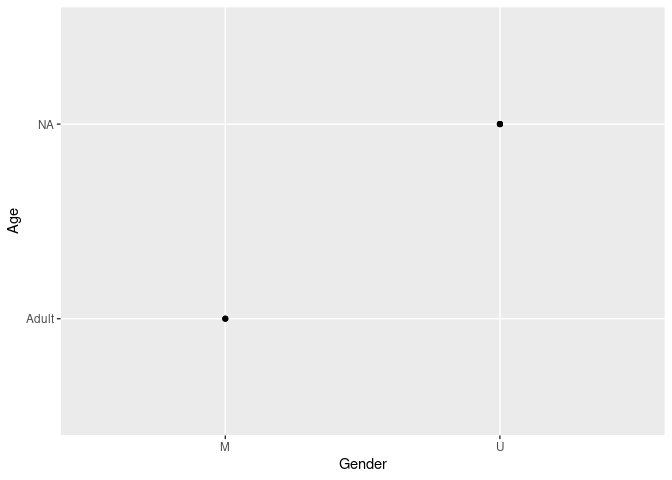You are including too few rows and it is not clear what kind of plot you are expecting to get from dots among categorical variables. This would be the result and it doesn't make much sense.
library(tidyverse)
dogbite <- data.frame(
stringsAsFactors = FALSE,
UniqueID = c(1, 2, 3, 4, 5, 6),
DateOfBite = c("January 01 2018",
"January 04 2018","January 06 2018","January 08 2018",
"January 09 2018","January 03 2018"),
Species = c("DOG", "DOG", "DOG", "DOG", "DOG", "DOG"),
Breed = c("UNKNOWN","UNKNOWN",
"Pit Bull","Mixed/Other","Pit Bull","BASENJI"),
Age = c(NA, NA, NA, "4", NA, "4Y"),
Gender = c("U", "U", "U", "M", "U", "M"),
SpayNeuter = c(FALSE, FALSE, FALSE, FALSE, FALSE, FALSE),
Borough = c("Brooklyn","Brooklyn",
"Brooklyn","Brooklyn","Brooklyn","Brooklyn"),
ZipCode = c("11220", NA, "11224", "11231", "11224", "11231")
)
Young <- c("0.2", "0.6", "04M", "1", "1 & 3", "1 & 8", "1 1/2 YRS",
"1 Y", "1 YR", "1 YR 8 Mon", "1 YRS", "1.3", "1.5", "1.6",
"1.8", "1/12M", "10 M", "10 MOS", "10 MTHS", "10 MTHS &",
"10 WKS", "10M", "10W", "10wks", "11 M", "11 MONS", "11 MOS",
"11 MTHS", "11 WKS", "11m", "11M", "11MOS", "11MTHS", "11W",
"11WKS", "12W", "12WKS", "12WKSKS", "13 WKS", "13M", "13WK",
"14M", "14WKS", "15M", "16 MONS", "16 MTHS", "16M", "16W",
"17M", "18 M", "18M", "18MTHS", "18W", "1M", "1Y", "1YR",
"1YR 8MONS", "2", "2(2) & (1", "2 & 9MTHS", "2 1/2", "2 MONS .",
"2 MTH", "2 MTHS", "2 YRS", "2-3 YR", "2-3 YRS", "2-3M", "2-3MOS",
"2-3YRS", "2.5", "2.6", "21M", "22 MTHS", "2M", "2y", "2Y", "2YRS",
"2YRS (MALE", "3", "3 & 4", "3 1/2 YRS", "3 M", "3 MONS", "3 MOS",
"3 MTHS", "3 YR", "3 yrs", "3 YRS", "3.5", "3.6", "3M", "3MTH",
"3mths", "3MTHS", "3Q", "3y", "3Y", "3YR", "3YRS", "4 M", "4 MONS",
"4 MTHS", "4-6MOS", "4m", "4M", "4MO", "4MTH", "4MTHS", "5 MTHS",
"5m", "5M", "6 MTHS", "6M", "6MO", "6MTH", "6MTHS", "7 M", "7 mons",
"7 MOS", "7 MTHS", "7-8M", "7m", "7M", "7MOS", "7MTH", "7MTHS",
"7W", "8 M", "8 MONS", "8 MOS", "8 MTHS", "8M", "8MTHS", "8W",
"8WKS", "9 M", "9 MONS", "9 MTHS", "9M", "9MTHS", "9WK")
Adult <- c("4","4 YRS", "4 yrs 8 mo", "4.5", "4.6", "4y", "4Y", "5", "5 yrs",
"5 YRS", "5Y", "5YR", "5YRS", "6", "6 & 4", "6 YRS", "6.5",
"6.5 YRS", "6.5Y", "6", "6y", "6Y", "7", "7 YRS", "7Y", "7YRS","8",
"8 YRS", "8Y", "8YRS & 8 M", "9", "9 YRS", "9Y")
Elder <- c("10", "10 &9", "10yrs", "10YRS", "10.5", "10+", "10y", "10Y","11",
"11YRS", "11-12YRS", "11Y", "12", "12 YRS","12Y", "13", "13 yrs",
"13 YRS","13Y", "14", "14YRS", "15", "15 YRS", "15.5","16", "17",
"17y", "19", "20", "21", "41", "68 yrs")
dogbite %>%
mutate(Age = case_when(
Age %in% Young ~ "Young",
Age %in% Adult ~ "Adult",
Age %in% Elder ~ "Elder"
)) %>%
ggplot(aes(Gender, Age)) +
geom_point()

Created on 2022-06-09 by the reprex package (v2.0.1)
Can you please clarify?
